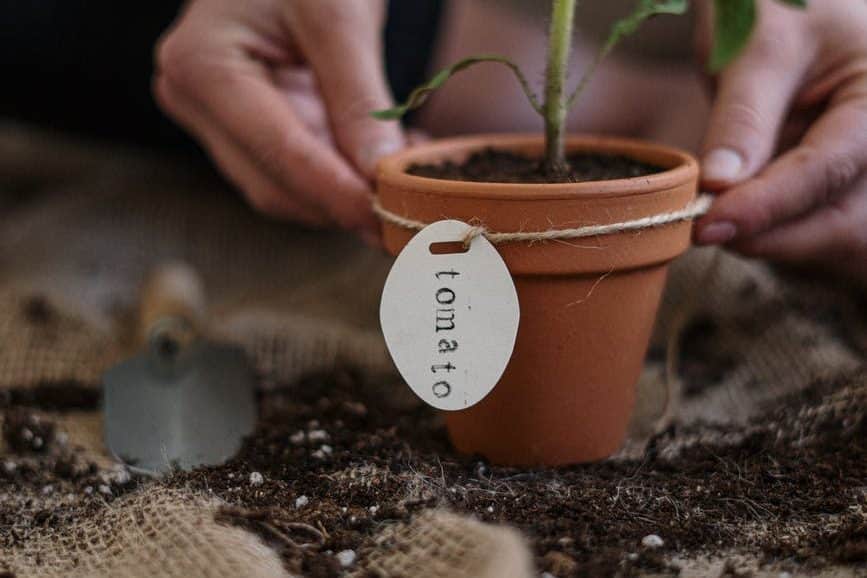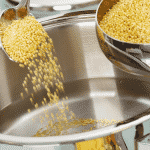We moved a couple of months ago to a new apartment and now finally had the chance to grow our vegetables. Since it was always our dream to eat home-grown tomatoes, we would like to share our top 10 tips that you should consider when growing those lovely vegetables. It can be quickly produced in flower pots on the balcony or veranda if no garden is available. For your tomato cultivation to succeed, however, there are a few things to consider. We’ll tell you what is essential.
- Choose the right type of tomato
- Find the right location
- A small greenhouse for delicate tomato plants
- In spring: sow and prick tomatoes
- Easy-care bush tomatoes for the balcony
- Tomatoes need sufficient space
- Don’t forget to fertilize
- Provide assistance, attach climbing aid
- Remove excess leaves and inflorescences
- The right time to harvest tomatoes
- At the end of the season: raise offspring
1. Choose the right type of tomato.
The choice is enormous: Tomatoes come in many different colors, shapes, and flavors. We, therefore, recommend planting more than one variety, especially in the first year. You can test a selection from cherry tomatoes to beefsteak tomatoes. Also, it is crucial to find a variety that grows well in your home under specific conditions.
2. Find the right location.
Tomatoes need nutrient-rich and well-drained garden soil; they don’t get waterlogged at all. They feel most comfortable in a warm, sunny place. It should also be primarily protected against wind and rain. A south wall, from which the sun is reflected and which provides additional warmth, is therefore well suited for cultivation in the garden.
If you don’t have a garden, you can easily grow tomatoes on the balcony. Many varieties also thrive in a tub or even in a planter bag. Whether on the terrace or in the garden, many types do not tolerate wet leaves particularly well.
3. A small greenhouse for delicate tomato plants
In hardware stores, you can get small plastic greenhouses, which you can use for your tomatoes so that they are protected. Because the plants also need adequate ventilation, they should be open on the sides. The roof of the greenhouse also protects the plants from said late blight and brown rot.
4. In spring: sow and prick tomatoes
As a hobby gardener, you can grow your tomatoes between mid-February and the end of March, preferably in a seed tray on your windowsill. It is best to place the seeds in nutrient-poor potting soil so that the seeds do not sprout too quickly. At temperatures of around 20 degrees, the first seedlings should grow after eight to ten days.
So that these do not die and do not hinder each other’s growth, it is essential that you prick them out after about three more weeks or, as they say, singularly. To do this, you put each plant in a single pot. The optimal temperature for germination of the seeds is 18 to 24 degrees Celcius.
5. Easy-care bush tomatoes for the balcony
The small bush or vine tomatoes are particularly suitable for cultivation in the balcony box. In contrast to the stick tomatoes, these are grown with multiple shoots, and there is no need to prune, i.e., break out the pinch shoots in the leaf axils. They also grow low and compact and are very productive. So that they develop many panicles despite the limited root space, it is best to plant them in high-quality balcony potting soil or special tomato soil.
6. Tomatoes need sufficient space
From mid-May, the small tomato plants can go into the ground, when there is no danger of soil frost. When the time comes, it’s best to plant them five to ten centimeters deeper than they were in the pot. Then they form additional roots around the stem base, with which they not only become more stable but can also absorb more water and nutrients.
Make sure that your plants have enough space in the bed. Around 2.5 plants per square meter are optimal. They should not be poured too much and put in nutrient-rich soil, because then the sugar and acid concentration as well as the proportion of dry matter in the fruit increases, which improves taste and shelf life.
7. Don’t forget to fertilize
Tomatoes remove a lot of nutrients from the soil, so you have to add them regularly, preferably from the beginning: You should add some compost as a starter fertilizer when preparing the bed. Then, when the plants start to flower, they need replenishment every two to three weeks. In specialist shops, you can get tomato fertilizer mixtures * that cover your nutritional needs without any further effort. The best thing to do is to enrich the bed with ripe compost in autumn. But be careful, don’t overdo it: If you fertilize too much, the plant will roll up its leaves.
8. Provide assistance, attach climbing aid
Except for the bush tomatoes, all types of tomatoes require climbing support, which you have to disinfect with denatured alcohol or a gas burner before use to avoid fungal diseases.
9. Remove excess leaves and inflorescences
For the tomato plant to put all its strength into the fruit, superfluous shoots must be broken off. The plants shouldn’t grow too big. Only five to a maximum of seven inflorescences can mature optimally. Therefore, cut the plants if they develop too many inflorescences. The gardener calls this “pruning.” This way, enough water, and nutrients get into the fruit. All leaves can be removed, especially below the first fruit cluster. The plant develops better, and the lower fruits get more light, ripen faster, and diseases do not spread as quickly.
10. The right time to harvest tomatoes
When you can harvest your tomatoes depends mostly on the weather in your harvest year. The sunnier and warmer the summer, the faster your plants will grow. The tomato variety and the start of cultivation also play a role. You can usually look for the first ripe tomatoes from July. Ripe tomatoes are entirely red, with no green spots. Yellow, green, orange, or dark fruits give a little under pressure. You can also detach the tomato from the fruit stem without applying excessive force.
11. At the end of the season: raise offspring
If you discovered an incredibly tasty variety for yourself in your first year as a tomato gardener, you would want to enjoy it again next year. To do this, you can create a seed supply at the end of the gardening season—the only requirement: the tomatoes must be firm to the seeds.
Because only from the seeds of non-seed varieties can tomatoes grow with the same properties as the mother plant. It is not the case with most commercially available plants and seed packages. If you have a seed-proof variety, it is not difficult to multiply: It is relatively easy to obtain seeds from the tomatoes, which you can dry and use for the next year.



